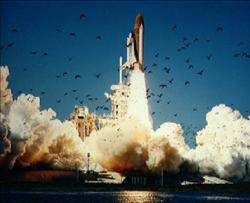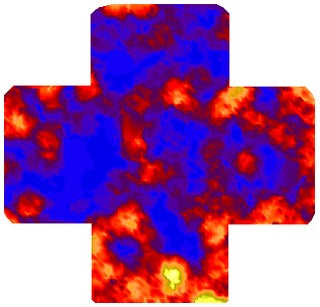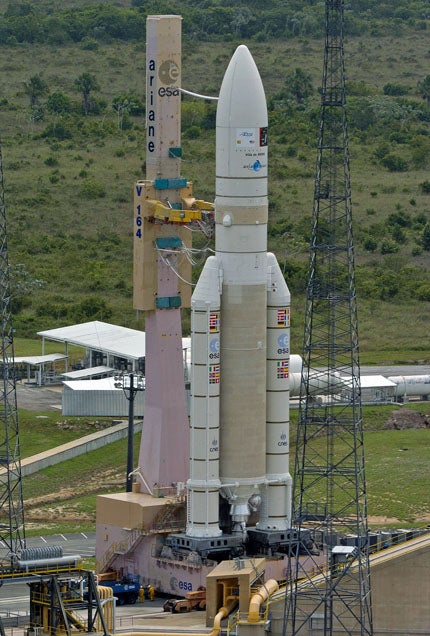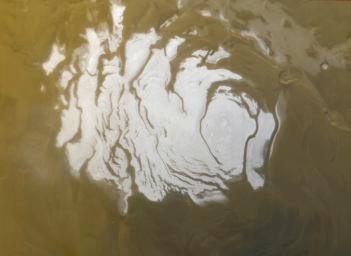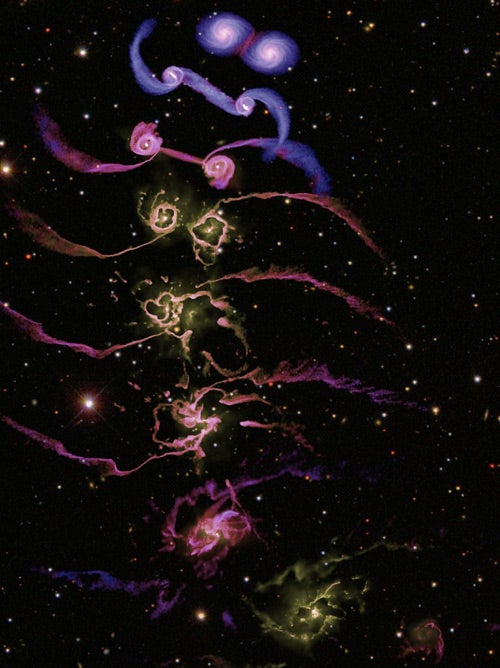Shuttle target launch date: May 15
The shuttle Discovery has a target launch date of May 15, according to William Readdy, NASA’s associate administrator for space operations. Reporting to the media via teleconference February 18, he said, “progress has been stunning.”
In a briefing by the independent Stafford-Covey task group yesterday (see below), cochair Richard Covey noted that he foresaw “no showstoppers” for NASA in meeting all 15 recommendations made by the Columbia Accident Investigation Board (CAIB). Covey also felt NASA could meet a recommendation from his task group that involved using the International Space Station as a temporary “safe haven” in case a shuttle reaches orbit but is too damaged to fly back to Earth.
Asked what NASA would do if one or more of the CAIB recommendations were unmet, Readdy said, “I don’t want to get into any kind of hypothetical end-game here.” He then reiterated the Stafford-Covey task group’s confidence that all the recommendations would be met.
The fallback plan for Discovery is that if something goes wrong during launch but the shuttle can reach orbit, the crew would fly to the International Space Station. There, they would await rescue by the shuttle Atlantis.
“We’re processing Atlantis and Discovery essentially in parallel,” said Mike Leinbach, NASA launch director. He noted that if a rescue proved necessary with Discovery, Atlantis would roll out to the pad May 23 and launch June 14.
Similarly, Leinbach said, if a rescue of Atlantis were needed after its next planned launch July 12, Discovery would be turned around and sent on a rescue flight to the space station. For the Atlantis astronauts marooned at the station, however, the wait would be lengthy. Said Leinbach, “A rough launch date we’re looking at [for Discovery] is September 6.”
— Robert Burnham
Testing the order of cosmic evolution
Astronomers have found evidence concerning the evolution of cosmic structure that may turn the favored theory upside down. Literally.
Scientists from an international collaboration using the Subaru/XMM-Newton Deep Survey (SXDS) have found galaxy clusters that formed a billion years after the Big Bang.
The accepted theory of structure formation — the “bottom-up” model — implies the first structures to form were clumps of matter smaller than galaxies. These structures congregated to form galaxies, then galaxy clusters, and finally, superclusters. The most important aspect of the bottom-up model is the hierarchy of evolution: small to big.
By saying clusters formed far earlier than believed, the SXDS astronomers contradict this model. The astronomers do, however, acknowledge that this finding does not mean cosmologists should throw out all earlier theories and start from scratch. “The real challenge is in understanding how well the distribution of visible matter such as galaxies correlates with the distribution of mass in general,” says Masami Ouchi, a group member currently at the Space Telescope Science Institute in Baltimore.
SXDS is currently gathering data in wavelengths from X rays to radio waves. When the survey is complete, a few years from now, scientists hope to be able to determine the details of cosmic evolution. The astronomers’ research appeared in the February 10, 2005 issue of The Astrophysical Journal. — Liz Kruesi
Shuttle: one more hurdle passed
The shuttle Discovery is one step closer to launch, still scheduled for sometime between May 14 and June 3, 2005. According to the independent advisory task group chaired by former astronauts Thomas Stafford and Richard Covey, NASA has successfully “closed” (fulfilled) another of the 15 recommendations made by the Columbia Accident Investigation Board (CAIB).
CAIB recommendation 3.3-1 told NASA to develop ways to check the integrity of the reinforced carbon-carbon (RCC) areas of the wings and tail during the turnaround time between shuttle flights. The Stafford-Covey panel had “conditionally closed” this recommendation in April 2004. In a teleconference among members February 17, the panel accepted NASA’s evidence that it can verify the RCC surfaces are safe using X rays, heat imaging, and airflow tests.
Of the eight CAIB recommendations left outstanding, one has been conditionally closed and seven still remain open. The Stafford-Covey group will meet again March 29 to 31 to determine the status of the remaining recommendations. In a teleconference with journalists following the panel’s meeting, cochair Richard Covey acknowledged that NASA still has a lot of work to do, but he foresaw “no showstoppers.” — Robert Burnham
Ariane 5 Heavy soars
Two years after an engine malfunction halted further launches, the European Space Agency’s (ESA) souped-up Ariane 5 ECA blasted into space from its French Guiana spaceport February 12. This heavy-lift version of Ariane 5 is designed to loft payloads of up to 10 tons — the equivalent of two communications satellites — to geostationary transfer orbit.
“It took 5 months to go through the analysis of the problems and develop a plan for return to flight,” says Antonio Fabrizi, ESA’s director of launches.
The rocket’s twin solid boosters and its liquid-fuel main stage both carry more propellant than the generic Ariane 5, and a new Vulcain 2 engine produces 20 percent more thrust. The rocket also sports a new high-performance liquid-fuel upper stage derived from the Ariane 4’s third stage. The upgrades allow Ariane 5 ECA to launch payloads about 30 percent heavier than its predecessor.
Starting with the next flight, scheduled for mid-year, Ariane 5 ECA will become the new European workhorse for lifting heavy payloads to geostationary orbit and beyond.
— Francis Reddy
The key to transforming Mars into a habitable planet is increasing its atmospheric pressure. If there were a way to warm the Red Planet’s polar caps by a modest amount (less than 20° C), scientists think carbon dioxide frozen there would become unstable, and Mars would experience a runaway greenhouse effect until all of its CO2 returned to the atmosphere.
Since no one knows how much CO2 is frozen on Mars, no one knows what the pressure of the warmed atmosphere would be. But a team led by Margarita Marinova at NASA’s Ames Research Center in California thinks it sees a way to kick-start the process.
Some industrial gases are nearly 10,000 times more effective at greenhouse warming than CO2 and water vapor, the Earth’s dominant natural greenhouse gases. So Marinova’s team looked for artificial gases that would have a long lifetime in the atmosphere, could be produced from materials readily available on Mars, and do not contain chlorine or bromine — elements that would destroy any ozone layer that might form.
The team’s report will be published in the February issue of the Journal of Geophysical Research – Planets. They find four gases were particularly effective, and one, octafluoropropane (C3F8), was a standout. Just adding 300 parts per million of the gas into Mars’ current atmosphere would do the job. Still, that’s billions of tons — too expensive to transport, so it would have to be produced on Mars itself.
“Since warming Mars effectively reverts it to its past, more habitable state, this would give any possibly dormant life on Mars the chance to be revived and develop further,” Marinova says. “Bringing life to Mars and studying its growth would contribute to our understanding of evolution, and the ability of life to adapt and proliferate on other worlds.”
— Francis Reddy
Black holes regulate their galaxies’ growth
Scientists have found that black holes release blasts of energy that regulate both galaxy evolution and black-hole growth.
In the group’s simulation, after two galaxies collide, their black holes merge into a supermassive black hole. This black hole then sucks up surrounding gas to power a quasar. The quasar energizes the surrounding gas and, eventually, the gas is blown away from the vicinity of the black hole. Because there is no more gas surrounding the black hole, it becomes dormant.
The researchers found “the black-hole mass and the mass of stars in a galaxy are closely linked,” according to Springel.
Small galaxies contain less gas, so not as much gas needs to fall into a central black hole before the gas is energized enough to be blown away. Because the gas is quickly blown away, fewer stars are made.
In comparison, a larger galaxy begins with a greater amount of gas. It takes longer for the gas to be heated enough to blow away, so there will be more stars there because there was more gas initially.
Not only does this simulation show that black-hole size correlates to the number of stars in a galaxy — which confirms what astronomers observe — but it also should allow scientists “to understand why quasars were more plentiful in the early universe than they are today,” says Hernquist. — Liz Kruesi
Volunteer opportunity for astronomers
Utah’s Bryce Canyon National Park invites anyone interested in volunteering with its astronomy program to submit a résumé. Public stargazing, telescope tours, and Full Moon hikes are becoming more popular as people are drawn to the scenic beauty and dark skies of southern Utah.
Commitments of 1 to 6 months are necessary. Free housing will be provided. Positions start May 1, 2005, and continue through October. Those chosen will play an integral part in the park’s robust interpretive programs and will have the opportunity to interact with thousands of park visitors.
For more information, contact Chad Moore at 435-834-4904; web site, www.nps.gov/brca/astro_volunteer.html. — Jeremy McGovern
SOHO’s 1,000th Comet Contest
The Solar and Heliospheric Observatory (SOHO) wants you to predict when its 1,000th discovered comet reaches perihelion.
Entries will no longer be accepted once SOHO finds its 960th comet. As of February 4, SOHO had discovered 906 comets. SOHO limits entries to one per person.
By correcty guessing the time and date when this comet makes its closest approach to the Sun, one grand-prize winner will receive a package that includes a SolarMax DVD, SOHO t-shirt, solar viewing glasses, and variety of SOHO materials. Second- and third-place winners will receive similar prizes.
For more information, visit SOHO’s site. — Jeremy McGovern
Some “missing matter” may be missing no more
While the search is still on for dark matter, astronomers have reportedly found the “missing” ordinary matter — also known as baryonic matter and the building blocks of stars, galaxies, etc. Astronomers can look back 10 billion years and see twice as much ordinary matter as detected at the present age of the universe. So where did it all go?
It may be in a cosmic web of gas clouds.
A group of astronomers led by Fabrizio Nicastro of the Harvard-Smithsonian Center for Astrophysics used the Chandra X-ray Observatory to spy radiation from the brightening of a quasar-like galaxy through intergalactic gas clouds. The spectrum showed traces of oxygen and nitrogen — baryonic matter.
The active galaxy, Markarian 421, is exceptionally bright. The astronomers were able to observe Mkn 421 for a total of 200,000 seconds in October 2002 and July 2003. From the data, they estimate most of the missing ordinary matter is within the intergalactic medium.
However, more observations — using different X-ray sources in other parts of the sky — are needed to confirm this conclusion.
The cosmological model says the universe’s composition is as follows: 70 percent is dark energy (composition unknown), 25 percent is dark matter (composition possibly known), and 5 percent is ordinary baryonic matter. Nicastro and his team may have revealed what 2.5 percent of our universe is made of, but future observations will confirm this. — Liz Kruesi
Shuttle computer models may mislead NASA
NASA should not rely too heavily on computer modeling to estimate potential damage from debris falling off the space shuttle’s external tank, says an independent oversight panel. Cochaired by ex-astronauts Thomas Stafford and Richard Covey, the panel issued on January 28 its third (and last) interim report on NASA’s progress toward returning shuttles to flight. The launch of the shuttle Discovery is scheduled for May or June.
The report mentioned, frequently in blunt language, that NASA still has to meet 8 of the 15 recommendations of the Columbia Accident Investigation Board. Moreover, they include the most technologically difficult tasks, such as minimizing debris from the tank (which caused the loss of Columbia), strengthening the reinforced-carbon-carbon leading edge of the shuttle’s wings and tail, and developing the ability to inspect the shuttle and make repairs while in orbit.
Regarding the issue of debris from the tank, which is the subject of greatest concern, the panel’s report says, “The current models cannot be used to precisely determine ‘allowable’ debris nor precisely assess the magnitude of risk reduction.”
The report’s summary concludes, “NASA has yet to demonstrate the rigor of the models necessary to certify the integrity of the Space Shuttle TPS [thermal protection system], including the ET [external tank]. Without validation of models, they should not be used for certification or risk assessment.”
Covey, who answered questions about the report in a conference call, noted the panel thought NASA could meet the final recommendations by the intended launch time. He also emphasized that the panel’s role was purely advisory: “NASA will ultimately determine if the remaining risk is low enough to launch the shuttle.” — Robert Burnham

